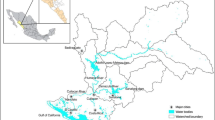Abstract
Agriculture is considered one of the vital activities in Egypt; it consumes about 83 % of the Egyptian Nile water quota. This activity is becoming negatively affected by water pollution causing negative repercussion on land productivity and subsequently food security. This paper assesses the water quality for agriculture along the mainstream of the Nile in Egypt through spatial distributions modelling of total dissolved solids (TDS), using spatial statistical analysis. The study’s sample frame consists of 78 sampling points collected in February 2008 and located on the Nile mainstream and its two branches, Rosetta and Damietta. Exploratory spatial data analysis is carried out on the TDS, followed by plotting and modelling the experimental semi-variogram. Then, cross validation is executed in order to determine the best fitting model. Finally, surface mapping is generated by performing spatial interpolation, using kriging technique. The generated surface map shows that the TDS levels increase from Upper to Lower Egypt, exceeds the standard limit in Beni-Suef and Rosetta branch. In fact, high levels of TDS are known to have a negative effect on Egyptian agriculture through harmfully affecting the soil and consequently the crop yields. Therefore, an analysis of the effect of water pollution on technical efficiency of crop production is conducted using a non-parametric mathematical programming approach to frontier estimation. The results of this estimation indicated that the TDS is overutilized in all governorates except Aswan.







Similar content being viewed by others
Notes
For details on this database and its construction consult Abou-Ali and Kheir-El-Din (2010).
This assumption allows representing the technology using an isoquant corresponding to producing one unit of output.
The best mix of inputs to produce the same output, since an input oriented measure is adopted.
References
Abou-Ali H, Kheir-El-Din H (2010) Economic efficiency of crop production in Egypt, Egyptian center for economic studies (ECES) working paper series, 155
Bordalo A, Nilsumranshit W, Chalermwat K (2001) Water quality and used of the Bnagpakong River. Water Res 35(15):3635–3642
CAPMAS (2009) Egypt in numbers. CAPMAS, Egypt
Central Department of Environmental Affairs—Center of Environmental Monitoring and Studies of the Working Environment (CEMSWE)—Ministry of Health, The Annual Report of the Results of the National Network for monitoring the water Pollutants of the Nile River and its Branches in 2008. Ministry of Health, Egypt (2008) (in Arabic)
Chang H (2008) Spatial analysis of water quality trends in the Han River Basin, South Korea. Water Res 42(13):3285–3304
Charnes A, Cooper WW, Rhodes E (1978) Measuring the efficiency of decision making units. Eur J Oper Res 2:429–444
Cooper WW, Seiford LM, Tone K (2007) Data envelopment analysis, 2nd edn. Springer, USA
Cooper WW, Seiford LM, Zhu J (2004) Data envelopment analysis: History, models and interpretations. In: Cooper WW, Seiford LM, Zhu J (eds) Handbook on data envelopment analysis. International Series in Operations Research and Management Science, 71. Springer, USA, pp 1–39
Dowd P (2003) Testing for constant spatial mean using the global D-statistic. Comput Geosci 29(8):1057–1068
Elmahdi A, Afify A, Abdin A (2008) Development of a GIS-based decision support tool and assessment of Nile River water quality. Int J Water 4(1/2):55–68
Emamgholizadeh S (2008) Water quality assessment of the Kopal River (Iran), international meeting on soil fertility, land management and agroclimatology, Turkey, pp 827–837
Farrell MJ (1957) The measurement of productive efficiency. J R Stat Soc 120(3):253–281
Flipo N, Jeannee N, Poulin M, Even S, Ledoux E (2007) Assessment of nitrate pollution in the Grand Morin Aquifers (France): combined use of geostatistics and physically based modelling. Envion Pollut 146(1):241–256
French J (2005) Exploring spatial correlation in rivers. Colorado State University, Dissertation
Forsund FR, Lovell CAK, Schmidt PA (1980) A survey of frontier production functions and of their relationship to efficiency measurement. J Econ 13(1):5–25
Fortin MJ, Dale MT (2005) Spatial analysis—a guide for ecologists, 1st edn. Cambridge University Press, Cambridge
Hamad S (2008) Spatial analysis of groundwater level and hydrochemsitry in the South Al Jabal Al Akhdar area using GIS. Slazburg University, Dissertation
Johnston K, Hoef J, Krivoruchko K, Lucas N (2001) Using ArcGIS geostatistical analyst, GIS by ESRI, Illustrated edn. ESRI, New York
Ministry of Agriculture and Land Reclamation (MALR), Agricultural Farm Income Survey. MALR, Egypt (2003/2004)
Ministry of Agriculture and Land Reclamation (MALR) (2009) Strategy for sustainable agricultural development 2030, 3rd edn. MALR, Egypt
Matheron G (1962) Traité de géostatistique appliquée, 1st edn. Technip Editions, Paris
Moran PAP (1950) Notes on continuous stochastic phenomena. Biometrika 37(1):17–23
Ouyang Y, Higman J, Thompson J, O’Toole T, Campbell D (2002) Charecterization and spatial distribution of heavy metals in sediment from Cedar and Ortega Rivers subbbasin. J Contam Hydrol 54(1/2):19–35
Rahman S, Hossain F (2008) Spatial assessment of water quality in peripheral rivers of Dhaka City for optimal relocation of water intake pointl. Water Resour Manag 22(3):377–391
Seiford LH (1996) Data envelopment analysis: the evolution of the state of the art (1978–1995). J Prod Anal 7:99–138
Sarangi A, Madramootoo CA, Enright P (2006) Comparison of spatial variability techniques for runoff estimation from Canadian watershed. Biosyst Eng 95(2):295–308
Vicente JR (2004) Economic efficiency of agricultural production in Brazil. Rev Econ Soc Rural 42(2):201–222
World Bank (2011) World Development Indicators. World Bank, Washington DC, USA
Acknowledgments
The authors are most grateful to Reda Mazloum, Abdel Hameed El-Shaarawi and Aliaa Zahran for their valuable comments, and to the Ministry of Health, CAPMAS and the Ministry of Agriculture and Land Reclamation for making the data available for this research. The usual disclaimer applies.
Author information
Authors and Affiliations
Corresponding author
Additional information
Handling Editor: Ashis SenGupta.
Rights and permissions
About this article
Cite this article
Abou-Ali, H., El-Ayouti, A. Nile water pollution and technical efficiency of crop production in Egypt: an assessment using spatial and non-parametric modelling. Environ Ecol Stat 21, 221–238 (2014). https://doi.org/10.1007/s10651-013-0252-5
Received:
Revised:
Published:
Issue Date:
DOI: https://doi.org/10.1007/s10651-013-0252-5




